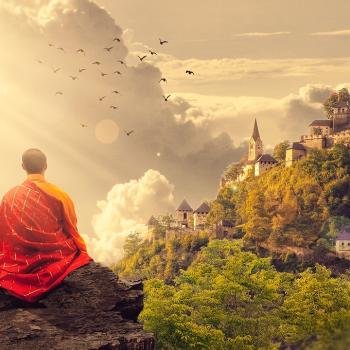“Empty Mindfulness – Presence of Mind”

Is it even possible to respond to the world without letting it all “get” to us? Can we be participants who somehow remain untouched by our surroundings? Those are important questions because most of us choose to become personally involved. We’d rather act out our humanity before we aspire to rise above it. Caught up in the excitement of being in the drama, who wants to sit back and just watch it?
Meditation
Yet those who meditate tell us that we can do both. Beneath the surface of the mind is calmness and peace, yes, they say. But beneath that is a bubbling spring of constantly new joy, happiness, and bliss. In fact, the practice of meditation probably dates back so many centuries because it is so rewarding and does not require giving up anything, least of all our joie de vivre. Well. . . something is given up, but it’s not easy to pinpoint just one thing. Stress? Vanishes. Breathing? Slows to a flutter. Concepts? Fade away. Mind? Empties. Time? Races by.
Meditation is as distinct from the three ordinary states of consciousness—waking, deep sleep, and dreaming—as they are from each other. It is the ultimate, total paradox; in nothing else are so many opposites merged. In meditation, we lose and find our identity, journey to where we are, practice what we can do, seek what we already know, and strive without any effort. Meditation is thinking thoughtless thoughts with the no-mind.
None of the above happens if we try to make it happen, though. Meditation is the doing of it. Not what we’ll get. Not what will happen, but moment to moment in/activity.
Let’s look at the letters I received from several correspondents, particularly from Sam, who has enjoyed the practice of meditation for many of his 70+ years and who wrote about it frequently. Here are some excerpts from his letters:
As I see it, meditation is tripped up by goals. Forget goals for meditation.
I don’t think you can meditate and have a goal at the same time. After meditating,
you can take up your goals, whatever they are.
Meditation is simply waiting to feel a deep quiet inside, and then dropping
into it. There’s nothing to achieve at all. (You’re already there but don’t know it.)
Just watch your breath and as you do, be aware of the gaps when it turns
from ‘in’ to ‘out’ and then again from ‘out’ to ‘in.’
THAT’S ALL!
Sam’s approach is very much like the Eastern approaches. They, too, stress no effort—sitting in meditation is enlightenment. But, they add, it is destroyed by desire for results. The Taoist doesn’t meditate because he wants to ‘get’ somewhere; he meditates as an expression of where he is. Because the Taoist values action without striving (wu-wei), the Taoist practice consists in:
Subtracting day by day,
Subtracting and yet again subtracting
Till one has reached inactivity.
But by this very inactivity
Everything can be activated.
As Sam pointed out:
People expect that knowing themselves must come with great effort.
Perhaps not. Perhaps only small efforts are needed, and the smaller the better,
like sitting still to find the part of us that breathes.
Follow Your Breath
A very ancient teaching is that the breath is tied to the mind, and so the rhythm of breathing changes according to one’s mental state. Anyone who is agitated, angry, restless, etc. is breathing very hard and fast. Anyone who is calm and relaxed is breathing slowly and regularly. It is impossible to breathe in a relaxed manner and to be angry at the same time. Based on this principle, slowing the breath works to calm the mind. As the breath gradually slows, so does the frantic mental activity of runaway thinking, judging, analyzing, and so on.
How does one slow the breath? Simply by focusing attention only on the breathing. The gaps between breaths are the same as the gaps between thoughts. Whenever the mind wanders, attention gently, but firmly, brings it back to the breath.
And the mind does want to wander! Following the breath reveals the extraordinary extent to which thoughts are linked. Each word brings up concepts, concepts bring up images, images bring up comparisons, and comparisons bring up judgments. “Inner chatter maintains the world,” Castaneda’s Don Juan taught. We can only enter that gap between thoughts if we go in quickly, before we start chattering to ourselves because otherwise, as Pat wrote in her letter, before one knows it, one is no longer meditating:
What disturbs me in meditating is not the presence of a thought so much
as the sudden, jolting awareness that I have been thinking for some time. A stream
of consciousness began when I wasn’t paying attention.
The presence of a thought itself is not so unsettling so long as one is
present and watching at the time the thought arises. With attention, one sees the
thought form and drift away alone without attaching others to itself.
It’s being aware, but not aware.
If we could be “present and watching,” as Pat said, it would be easier. Aware of a thought as it forms, we could let it go. But when we are not “present,” “we” are absent, and the mind is invaded by past and future time, the intruders in meditation, knocking at the door marked “now.”
Now Moment
Just as action can only be taken in the present or not at all, so thoughts can only be in the present. In the present we may think of the past or of the future, but only the present exists. All else is mental creation—memory and expectation. The physicist Schroedinger wrote, “For eternally and always there is only now, one and the same now; the present, the only thing which has no end.”
The heightened awareness of being in the present is called “mindfulness” in the East. It means a total concentration in anything, not just meditating. The best performers, the best athletes exhibit mindfulness; they have “presence,” completely absorbed and focused, concentrated and controlled.
Meditation is very similar, except it would be better termed “empty mindfulness.” While the performer thinks about the object of his attention, the meditator pays attention without thinking about an object. Awareness is more of the space around thoughts than of the thoughts themselves. For a while, at least, all boundaries, divisions, walls and boxes within the mind fall away. Without opinions to support them, all opposites are integrated. Krishnamurti said,
If you can observe alertly, keenly, but without judging, without concluding, you will find that your thinking becomes astonishingly acute. Then you are learning all the time. . . when the mind is therefore capable of seeing what is from moment to moment without wanting to change it—in that very moment is the eternal.
This state beyond time and thoughts can only come by forgetting past and future. Perhaps that is why some say, “There is no such thing as ‘empty mind.’ There is only present mind.” When one is quiet yet awake, alert yet empty of discursive thinking, this moment is to be found in the interval between two thoughts. As we wait and watch, thoughts slow to the point where each isolated one may be barely observed in turn. They come and go, rise and fall, thrown up on the shore of the mind and, unless they are seized, wash away again.
In the stillness of a mind unruffled, as in a calm and smooth surface of water, the unchangeable, silent pure essence of the self is reflected. At that moment, one simply and totally IS. In this moment of intuitive contact with the obscure presence of the Spirit, this mysterious union, is the interpenetration of the individual and the divine. The highest prayer is the most passive: “Be still and know that I am God.” (Psalm 46:10)
In meditation the “I” can lose the “me.” It has been described as “an aware walk into sleep and death” that pierces the darkness. The first feeling to come in meditation is usually a deep, flowing peace. The first fear to leave is said to be the fear of death. In the East, the Taoists said long ago:
All agree in the one proposition, the finding of the spiritual Elixir in order
to pass from death to life. In what does this spiritual Elixir consist? It means
forever tarrying in purposelessness. The deepest secret in our teaching. . .is
confined to the work of making the mind empty. Therewith the mind is set at
rest. What I have revealed here in a word is the fruit of decades of effort.
Decades of effort with no effort to realize an empty mindfulness that was there all along! “Tarrying in purposelessness” seems to say it all—no goals, no sense of time or urgency, taking forever in a moment of now.
Presence
Most of the time, results are felt later. They are subtle, cumulative, quiet, like a garden growing. A seed has been planted. Chuang Tzu described “the mark of a mind at ease.” He said, “It does not change inside and is not affected by external events, and one feels at ease in all circumstances and situations. Once at ease, it is never again not at ease.”
Eventually, a magic comes over the meditator. Activity stays on the circumference, but within, at the center, there is a deep, silent peace. Anna wrote this:
I can still get to an angry state sometimes. I just can’t stay there anymore.
Nothing is worth giving in to negative moods. They’re too disruptive. It takes a lot
of time and work to climb back up out of the negative. Being angry with another
person places a barrier between myself and God who is in all.
There’s too much joy and happiness in the world to cut myself off from it
and interrupt my flow of peace.
The peace of mind that is undisturbed by the world comes with sensing the Presence of God. The advice of Monoimus was:
Learn whence is sorrow and joy, and love and hate, and waking though one would not, and getting angry though one would not, and falling in love though one would not. And if thou shouldst closely investigate all these things, thou wilt find God in thyself, one and many, just as the atom; thus finding from thyself a way out of thyself.
To practice that presence of mind, not just in contemplation, but in the midst of activity, is to let the mind, as often as possible, rest in God, the most powerful thought in the world.












